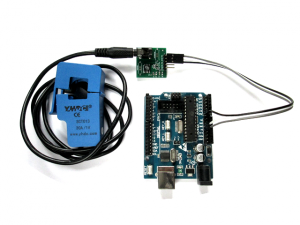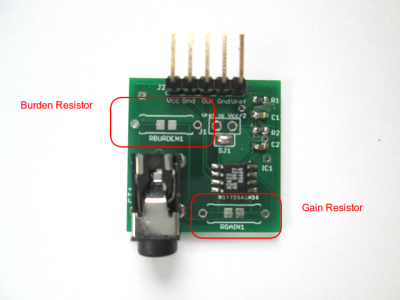Current Transformer Conditioner: Difference between revisions
(→Vref) |
(→Vref) |
||
| Line 298: | Line 298: | ||
=Vref= | =Vref= | ||
[[File:IMG_1846_small_02.png | 400px | right]] | [[File:IMG_1846_small_02.png | 400px | right]] | ||
Vref is the center of the waveform and is set | Vref is the center of the waveform and is set by default as half the supply voltage. | ||
Why? As most ADC scale are set between 0 and 5V (or other positive voltage) it is not possible to measure a waveform with a negative part. It miss the negative part due to the limit at 0. To face this we can offset the signal higher at say 2.5V. Then when negative the waveform will be below 2.5V and above when positive. | Why? As most ADC scale are set between 0 and 5V (or other positive voltage) it is not possible to measure a waveform with a negative part. It miss the negative part due to the limit at 0. To face this we can offset the signal higher at say 2.5V. Then when negative the waveform will be below 2.5V and above when positive. | ||
Revision as of 21:52, 10 March 2023

The CT Conditioner allows to connect a CT sensor to an Arduino board.
- Supports both current and voltage output CT.
- 3.5mm Jack connector CT port.
- Amplification easily setup by mean of a resistor.
- Zero offset can be set to Vcc/2 onboard. Or use an external reference.
- Uses instrument amplifier AD623 for accurate result.
- Provision of a burden resistor mounting for current output CTs.
- Minimum setup uses 3 wires. +5V Gnd and analog out.
- Dimensions: 24x24mm
Usage

Connect the CT sensor to the jack connector. Then connect 3 wires to the Arduino. The 3 wires to connect are
CT conditioner -> Arduino Vcc -> 5V Gnd -> Gnd Out -> A0
Note Vcc can also be connected to 3.3V.
Compatible CT
Any CT with a 3.5mm jack connector will be supported.
Voltage CT
No burden resistor should be fitted using a Voltage CT. These are commonly
SCT-013-005
SCT-013-010
SCT-013-015
SCT-013-020
SCT-013-025
SCT-013-030
SCT-013-050
SCT-013-060
Current CT
A burden resistor must be used when using current output CT. These are commonly
SCT-013-000
SCT-006
SCT-019
Sketch Example
A simple arduino sketch can be used to read the value every seconds. See the example below.
You must download and install the RPICTlib to compile the sketch.
http://lechacal.com/RPICT/RPICTlib/RPICTlib_v1.4.1.zip
// CT Conditioner Demo
// Version 1.2
// lechacal.com
//
// Required Libraries
// RPICTlib 1.4.1
// http://lechacal.com/RPICT/RPICTlib/RPICTlib_v1.4.1.zip
//
#include "RPICTlib.h" // Include the library
int sInterval = 250; // 250usec is 4kHz sampling interval (internal sampling)
// We use 1000 samples to measure the rms signal.
// Ideal value depends on frequency
// for example for 50Hz using 10 full cycles
// N = 1000000 * 10 / 50 / 200
int NUMBER_OF_SAMPLES = 1000;
SignalNode ct1; // CT computation node definition
void setup()
{
Serial.begin(38400); // Open the serial port
adc_definition(10, 5000); // Tell the library we are on 10 bits and 5V voltage reference.
ct1.begin(A0, 30.00); // Analog port A0, 30 scaling factor for SCT-013-030
}
void loop()
{
ct1.calcRMS(NUMBER_OF_SAMPLES, sInterval); // Measure and compute Irms
if (ct1.err) {
Serial.println("err"); // Error. Current is too high and goes over-limit. (or maybe change sInterval to 400 (unlikely)).
} else {
Serial.print(ct1.RMS); // Print the result
Serial.println(" A"); // Print the unit (Ampere)
}
delay(1000); // wait 1 second
}Default Setup
By default the CT conditioner comes without resistors fitted for both Burden and Gain.
This means this is ready for a voltage output CT and the Gain is 1.
Resistor
Fitting

There are 2 types of resistor the user can fit on the CT conditioner. These are not mandatory but will help optimising the measurement.
Both surface mount and though hole resistor are supported. Surface mount resistor case are 0805 size.
Burden Resistor
When a current output CT sensor is used a resistor must be soldered to the CT conditioner. It is usually recommended to use a low value resistor. Also the datasheet of the CT should have some indication on the maximum resistor to use. Burden resistor is also called sampling resistor in some documentations.
Note that you do not need a burden resistor if the CT is voltage output.
Amplification
A second resistor can be fitted on the CT conditioner to adjust the amplification level. Amplification can be required if levels are found too low. For low currents this can increase resolution.
From a desired gain the resistor can be calculated as follow
G is the Amplification Gain.
Rg is the resistor value in ohm.
The formulae below should be used to estimate the Gain.
G = Vadc/Vct/2√2
Vadc is the full scale voltage value of the ADC. Usually 5V or 3.3V.
Vct is the output voltage of the current transformer at maximum desired value (rms).
Example
Here is an example of Gain calculation.
Let's take the SCT-013-030. This outputs 1V at 30A (both rms and peak). Hence ICAL = 30.
Using an Arduino UNO the ADC has 5V reference by default. Hence Vadc = 5.
We would like to measure 30A rms (i.e. 1V rms) at the maximum scale of the ADC. Hence Vct = 1.
We can estimate the required gain as follow:
- G = 5/1/2√2 = 1.77.
Then the required resistor for this Gain is:
- Rg = 100000/(1.77-1) = 130Kohm.
We can now calculate the theoretical scaling coefficient to enter in the sketch:
- newICAL = ICAL/G = 30/1.77 = 16.95
We will then fit a 130kOhm resistor and enter in the sketch
ct1.init(A0, 16.95);
Recommended Values
| CT | Output Type | Rburden | Rgain (for 5V) | ICAL (for 5V) | Rgain (for 3.3V) | ICAL (for 3.3V) |
|---|---|---|---|---|---|---|
| SCT-013-005 | Voltage | None | 130 kΩ | 2.83 | None* | 5.0 |
| SCT-013-010 | Voltage | None | 130 kΩ | 5.66 | None* | 10.0 |
| SCT-013-015 | Voltage | None | 130 kΩ | 8.49 | None* | 15.0 |
| SCT-013-020 | Voltage | None | 130 kΩ | 11.31 | None* | 20.0 |
| SCT-013-025 | Voltage | None | 130 kΩ | 14.14 | None* | 25.0 |
| SCT-013-030 | Voltage | None | 130 kΩ | 16.96 | None* | 30.0 |
| SCT-013-050 | Voltage | None | 130 kΩ | 28.28 | None* | 50.0 |
| SCT-013-060 | Voltage | None | 130 kΩ | 33.94 | None* | 60.0 |
| SCT-006 | Current | 10 Ω | 17 kΩ | 11.62 | 28 kΩ | 17.5 |
| SCT-013-000 | Current | 10 Ω | 39 kΩ | 56.12 | 75 kΩ | 85.71 |
| SCT-019 | Current | 10 Ω | 24 kΩ | 116.13 | 40 kΩ | 171.43 |
* For all the None* calculated amplification is 1.17. Being close to 1 we do not consider it is worth installing a resistor.
ICAL values are theoretical. You might need to adjust them with a calibration if you want to get more accurate values.
Resistor values in bold in the above table are provided with the kit. Their colour coding is shown below for reference.
| Resistor Value | Colour Code |
|---|---|
| 10Ω | 
|
| 39kΩ | 
|
| 75kΩ | 
|
| 130kΩ | 
|
Vref

Vref is the center of the waveform and is set by default as half the supply voltage.
Why? As most ADC scale are set between 0 and 5V (or other positive voltage) it is not possible to measure a waveform with a negative part. It miss the negative part due to the limit at 0. To face this we can offset the signal higher at say 2.5V. Then when negative the waveform will be below 2.5V and above when positive.
By default Vref is connected to Vcc/2 (2.5V or 1.65V). This is done with the solder blob shown on this picture. The Vcc/2 is achieved using a voltage divider with 2x 10k resistors on the board.
If you prefer using an external Vref then disconnect Vref from Vcc/2 by removing the blob with a soldering iron. Then Vref can be set from an external source on one of the pin of the CT conditioner.
Playground: View the waveform
Using a simple sketch one can view the waveform easily using an application called SerialPlot.
SerialPlot
Download SerialPlot from here.
Make sure ASCII is selected in the Data Format tab.
Sketch
Upload the sketch below to the arduino.
// CT CONDITIONER WAVEFORM DEMO
// VERSION 1.0
// LeChacal.com
//
// Description
// Read waveform from pin A0. Then send data over serial to be read by Serialplot application.
//
//
const int N = 512; // Length of storage buffer
uint16_t BUFFER[N]; // Storage buffer - Array to store analog data
const int INTERVAL = 285; // Sampling interval approx 3.5kHz
const float ICAL = 30; // Using SCT-013-030 CT here
const float VCC = 5.0; // Vcc is 5V
const float VREF = 2.5; // Using the Vcc/2 reference here as setup by default on teh conditioner.
void setup() {
Serial.begin(9600); // Setup the serial port
pinMode(A0, INPUT); // Setup pin A0 as input
}
void loop() {
fill_buffer(A0);
print_buffer();
}
// Function to read analog data and store into array BUFFER.
void fill_buffer( byte _PIN)
{
unsigned long timer1 = 0;
unsigned int i = 0;
while (i < N) {
if ((micros() - timer1) > INTERVAL) {
timer1 = micros();
BUFFER[i] = analogRead(_PIN);
i++;
}
}
}
// Function to print the buffer
void print_buffer()
{
unsigned int i;
for (i = 0; i < N; i++) {
//Serial.println(BUFFER[i]);
Serial.println(((float)BUFFER[i]*VCC/1024-VREF)*ICAL);
}
}



